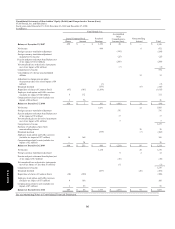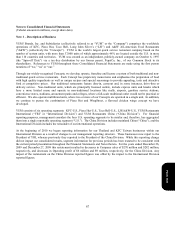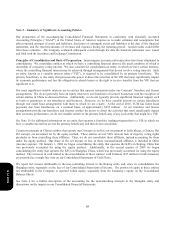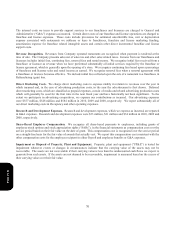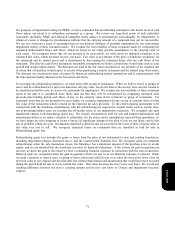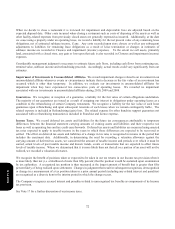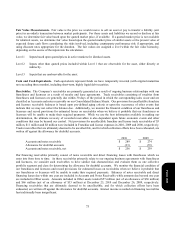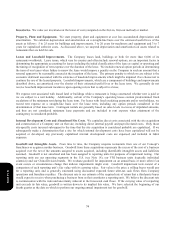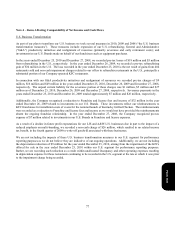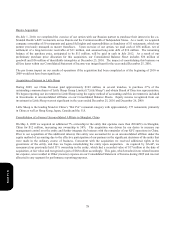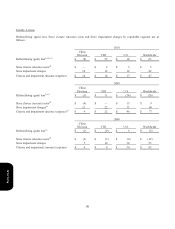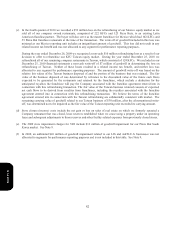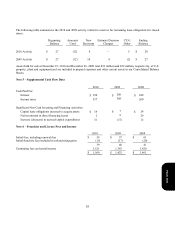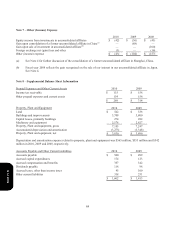Pizza Hut 2010 Annual Report Download - page 172
Download and view the complete annual report
Please find page 172 of the 2010 Pizza Hut annual report below. You can navigate through the pages in the report by either clicking on the pages listed below, or by using the keyword search tool below to find specific information within the annual report.
75
If we record goodwill upon acquisition of a restaurant(s) from a franchisee and such restaurant(s) is then sold within two
years of acquisition, the goodwill associated with the acquired restaurant(s) is written off in its entirety. If the restaurant
is refranchised two years or more subsequent to its acquisition, we include goodwill in the carrying amount of the
restaurants disposed of based on the relative fair values of the portion of the reporting unit disposed of in the refranchising
and the portion of the reporting unit that will be retained. The fair value of the portion of the reporting unit disposed of in
a refranchising is determined by reference to the discounted value of the future cash flows expected to be generated by the
restaurant and retained by the franchisee, which include a deduction for the anticipated, future royalties the franchisee will
pay us associated with the franchise agreement entered into simultaneously with the refranchising transition. Appropriate
adjustments are made if such franchise agreement is determined to not be at prevailing market rates. The fair value of the
reporting unit retained is based on the price a willing buyer would pay for the reporting unit and includes the value of
franchise agreements. As such, the fair value of the reporting unit retained can include expected cash flows from future
royalties from those restaurants currently being refranchised, future royalties from existing franchise businesses and
company restaurant operations. As a result, the percentage of a reporting unit’s goodwill that will be written off in a
refranchising transaction will be less than the percentage of the reporting unit’s company restaurants that are refranchised
in that transaction and goodwill can be allocated to a reporting unit with only franchise restaurants.
We evaluate the remaining useful life of an intangible asset that is not being amortized each reporting period to determine
whether events and circumstances continue to support an indefinite useful life. If an intangible asset that is not being
amortized is subsequently determined to have a finite useful life, we amortize the intangible asset prospectively over its
estimated remaining useful life. Intangible assets that are deemed to have a definite life are amortized on a straight-line
basis to their residual value.
For indefinite-lived intangible assets, our impairment test consists of a comparison of the fair value of an intangible asset
with its carrying amount. Fair value is an estimate of the price a willing buyer would pay for the intangible asset and is
generally estimated by discounting the expected future after-tax cash flows associated with the intangible asset. We also
perform our annual test for impairment of our indefinite-lived intangible assets at the beginning of our fourth quarter.
Our definite-lived intangible assets that are not allocated to an individual restaurant are evaluated for impairment
whenever events or changes in circumstances indicate that the carrying amount of the intangible asset may not be
recoverable. An intangible asset that is deemed impaired on a undiscounted basis is written down to its estimated fair
value, which is our estimate of the price a willing buyer would pay for the intangible asset based on discounted expected
future after-tax cash flows. For purposes of our impairment analysis, we update the cash flows that were initially used to
value the definite-lived intangible asset to reflect our current estimates and assumptions over the asset’s future remaining
life.
Derivative Financial Instruments. Historically, our use of derivative instruments has primarily been to hedge risk
associated with interest rates and foreign currency denominated assets and liabilities. These derivative contracts are
entered into with financial institutions. We do not use derivative instruments for trading purposes and we have procedures
in place to monitor and control their use.
We record all derivative instruments on our Consolidated Balance Sheet at fair value. For derivative instruments that are
designated and qualify as a fair value hedge, the gain or loss on the derivative instrument as well as the offsetting gain or
loss on the hedged item attributable to the hedged risk are recognized in the results of operations. For derivative
instruments that are designated and qualify as a cash flow hedge, the effective portion of the gain or loss on the derivative
instrument is reported as a component of other comprehensive income (loss) and reclassified into earnings in the same
period or periods during which the hedged transaction affects earnings. For derivative instruments that are designated and
qualify as a net investment hedge, the effective portion of the gain or loss on the derivative instrument is reported in the
foreign currency translation component of other comprehensive income (loss). Any ineffective portion of the gain or loss
on the derivative instrument for a cash flow hedge or net investment hedge is recorded in the results of operations
immediately. For derivative instruments not designated as hedging instruments, the gain or loss is recognized in the
results of operations immediately. See Note 12 for a discussion of our use of derivative instruments, management of
credit risk inherent in derivative instruments and fair value information.
Form 10-K



